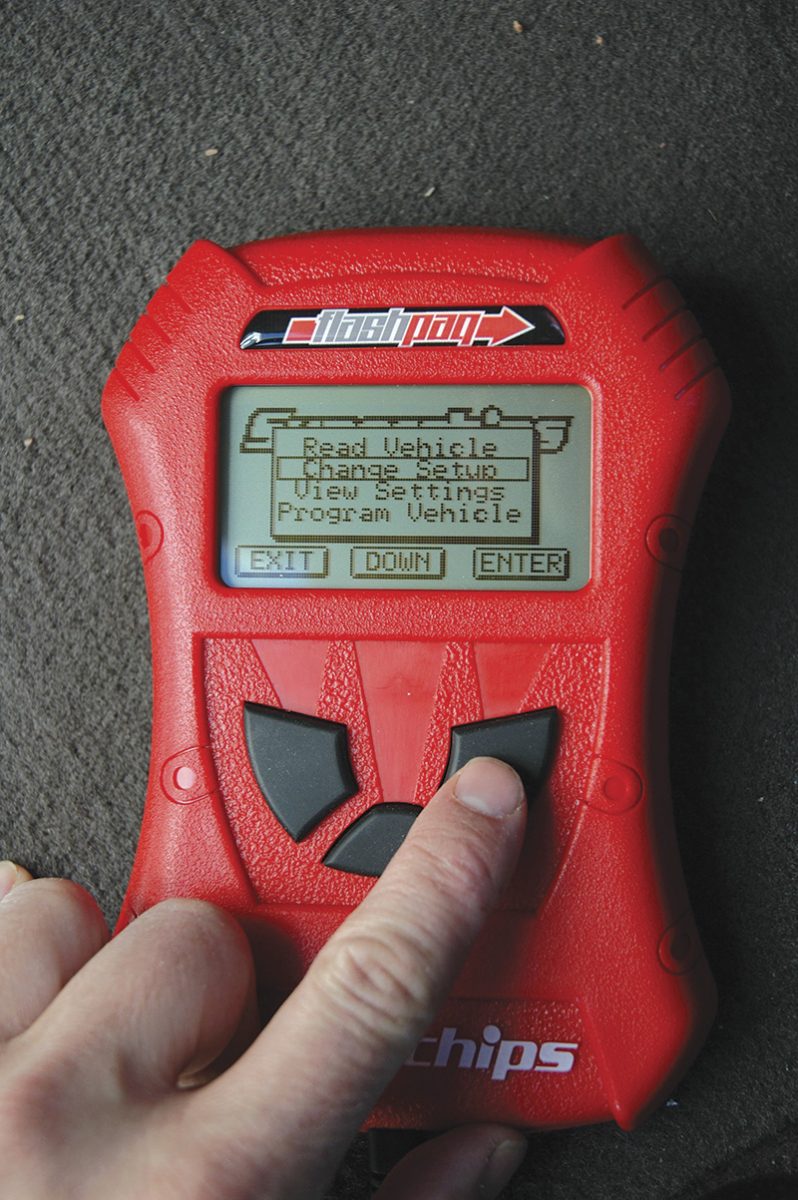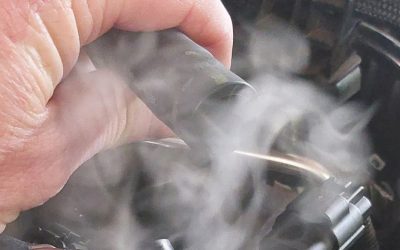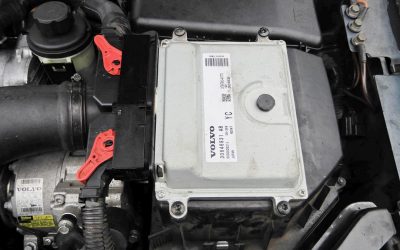Performance and Economy Through Engine Management.
The advent of electronic engine-management controls to help reduce emissions brought about a revolution in efficiency in the automotive world. With engine control units (ECU) and various sensors located throughout the engine and transmission, engineers gained electronic rather than only mechanical control over air/fuel mixture, fuel pressure, shift points and more. Various performance parameters could be adjusted on the fly and matched to driving conditions. Almost instantly, the automotive aftermarket began to hot rod the electronics packages. Rather than swapping out a camshaft or installing larger carburetor jets, technically savvy performance enthusiasts began to alter the ECU programming to optimize electronic fuel injection and ignition timing.

Prior to 1996, most ECUs stored the engine-management data on a PROM (programmable read-only memory) module. As specialty-equipment manufacturers developed new programs and created replacement modules, the performance “chip†business was born. To change the performance characteristics of the engine, an installer physically removed the stock chip and replaced it with the aftermarket unit, but only truly hardcore enthusiasts sought to create new chips themselves. In many cases today, however, changing the functions of the ECU can be as simple as plugging a module into the factory diagnostic datalink connector and pressing a few buttons. In other instances, a tuning module can be wired in to interface with the ECU. At the extreme end of electronic engine tuning, the whole computer package can be swapped out.
The first method, the plug-in, uses a handheld device that carries its own is minicomputer. This type of tuning, called reprogramming or reflashing, is the easiest and most convenient. A reprogrammer can be used to alter the factory calibrations for fuel, spark and even boost management, in the case of the turbocharged diesels engines found in many of today’s trucks.
“This method is limited to the constraints of the factory sensors and the output capabilities of the factory systems,†explained Peter Treydte, director of technical communications for Gale Banks Engineering, “but they may also offer the benefit of altering calibrations for other devices such as the transmission. These types of devices may also offer the ability to act as a scan tool, reading and clearing stored diagnostic codes.â€
A consumer or installer can download the vehicle’s stock program to save in one of these handheld devices and then upload the performance program into the ECU. The stock program is retained in the reprogrammer so that the ECU can be brought back to stock condition if, for instance, the vehicle must be returned to the dealership for service or repair. In addition, some reprogrammers may offer two, three or more types of programs that can be easily installed or uninstalled. For example, an enthusiast may want to program for better horsepower and torque, while a sportsman may want better towing capability and fuel economy. The variety of programs changes the control parameters to suit the need.
The second type of tuning device “piggybacks†onto the ECU. This is the type that interfaces with the ECU through underhood connections, where it intercepts signals sent from the various engine sensors to the ECU and then sends altered outputs to the factory electronics.
“A benefit of this type of tuner is the option to add additional signals into the information stream that would otherwise not be present with the factory electronics alone,†Treydte said. “One example of this is in late-model diesel pickup trucks. One of the most critical measurements that an operator may observe is exhaust gas temperature (EGT), but the factory electronics do not provide an EGT sensor. A diesel tuner such as the Banks Six-Gun allows for a temperature probe to be incorporated into the system, allowing the EGT to be a contributing factor in the final fuel calibration.â€
The most extreme method available for electronic engine tuning would be to completely replace the factory electronics—ECU, wiring, sensors, injectors and other components—which offers the greatest flexibility and tuning capability but is also obviously far more involved. Usually a user must set up the tuning parameters using a laptop computer, and this of type wholesale change also requires greater engine-tuning expertise.
The plug-in reprogramming devices are so straightforward to use that practically anyone can operate them, and the current versions of the inline or downstream products that are wired in under the hood are nearly as simple to install. The results, however, can be eye opening. The manufacturers we spoke with said that gasoline engines can routinely achieve 15 to 20 horsepower increases at the rear wheel, and in turbodiesel applications—where air management is more pronounced because of the tuning program’s influence on the turbocharger—increases well above 100 horsepower and torque gains far in excess of 200 ft-lbs are commonplace. And while fuel-economy gains are not as pronounced, they are definitely discernable…if the driver controls his right foot.
“At any given road speed (depending upon vehicle weight, aerodynamic drag, load and so on) a certain amount of road horsepower is required to propel the vehicle,†said Jim McFarland, executive director of communications, marketing and special projects for Hypertech. “Increased torque (power) is especially noticeable for tuned diesel engines, where higher-than-gasoline-engine levels of power can be obtained. In particular, increased power tends to reduce the amount of down-shifting required to tow or maintain road speeds, especially in heavier vehicles being used on hilly terrain. This tends to reduce fuel consumption by decreasing net air/fuel flow in a lower range of engine speed.â€
As the price of oil continues to spiral upward, tuner manufacturers have become more emphatic about producing devices that aid fuel economy. Some provide specific programming options that address fuel economy, and others now have their research-and-development teams at work to produce even better results. In addition, the current crop of tuners offers ever-increasing flexibility.
“Many tuners have accessory devices available that can act as input and output devices,†said Treydte. “The Banks PowerPDA is a vehicle command center based on the popular Palm Tungsten platform. It allows the use of a versatile PDA to display gauge functions, change power levels on the fly, custom tune the Banks Six-Gun, run and record performance tests and provide diagnostic capabilities while still offering the full functionality of a PDA. Accessories like the PowerPDA add an extra level of gadgetry for those that like to go a little deeper into the capabilities of their vehicle and their tuning devices.â€
Each tuning-product manufacturer offers technical assistance to both installers and consumers. As tuners continue to become more sophisticated, however, some companies now offer additional training for installation and service personnel.
“The standard instruction for installers is just the instruction manual that comes in the box,†said Dan Dolan, national manufacturer’s sales representative for Diabloport. “But for advanced dealers who are doing custom tuning on dynos, we do offer a training program where someone comes out to their facility and shows them how to create and install Predator tunes and load backups from the Predator to a computer and so on. Still, the manual should suffice for the standard installer or jobber installer who isn’t really interested in custom tuning. It’s a very easy product to use.â€
With each of these tuning devices, the topic of the factory warranty comes into play. While warranties should not be refused, some dealerships may try to get their customers to believe that tuning devices can be cause to disallow warranty repairs.
“According to the Magnuson-Moss Act, the mere installation of a non-stock (non-OEM) part should not be cause to void a warranty,†said McFarland. “In fact, the aftermarket part manufacturer is liable only if the modifying part is shown to have caused a part or system failure. However, we have some new vehicle dealerships that sell and install Hypertech tuning while other will categorically void a warranty if tuning has been used. Both Ford and GM have issued documents to dealerships that instruct warranties to be voided if a ‘power up’ device has been used. I deal with these issues on a routine basis because consumers typically have nowhere to go if a failure occurs. In three years of dealing with this problem—and Hypertech has sold tens of thousands of re-programmers—not one failure for which a warranty was denied has been traced to a Hypertech product. But it’s still a problem. Where possible, we advise customers to talk to their dealership of choice to see what lines they follow regarding warranties before vehicle purchase.â€

It’s those dealers who categorically refuse warranty when a tuner has been used that lead some manufacturers to instruct consumers to return the tuning to stock before any dealer service or repair. With reprogrammers, it’s a simply matter of uploading the stored factory tuning, but the hardwired downstream tuners require more work.
“It’s very easy for an OE to tell a consumer that the reflash tuner has caused a problem and voids the warranty,†explained Rick Rollins, vice president of sales and marketing for Superchips Inc. “It’s a difficult case because there isn’t a hard part to investigate. There’s not a camshaft that broke or a rod or a rod cap. There’s nothing there to really investigate and say it caused the problem. On the other side of it, however, a service manager for a territory may tell his dealerships that he won’t warranty any work if the vehicle had a tuner on it because he knows that it’s a hard case to prove, so he’s going to bluff the customer by saying they’re not going to pay for it. We suggest that consumers remove our tuning before they go into the dealership. Not that our tuning causes a problem. We sell thousands of units every month, and we don’t have problems. In fact, there are times when we could make far more horsepower than we do, but we know that the powertrain won’t handle it, so we tune it back.â€
As for the tuning devices themselves, the manufacturers we spoke with all offered reasonable warranties for their products. In many cases, consumers were provided with a 30-day money-back guarantee that was augmented with a limited lifetime warranty on materials and workmanship. Of course, it’s up to the installer and/or consumer to fully investigate product warranty to ensure that the installation is protected against premature failure.
It’s also important to note that not every tuning-device manufacturer offers products for every make and model of automobile. Some manufacturers offer reprogrammers for only the Detroit Big Three products: Ford, GM and DaimlerChrysler.
“When I first came to Superchips,†said Rollins, “we did everything—Ferrari, Maserati, Lamborghini, BMW, Porsche—but as sophisticated as the computers have gotten and with all of the sensors and safety controls that the OEs are putting in the systems, there’s just not enough man hours to keep up with all of the different operating systems and computer systems. Even the Big Three are now changing systems every other year or more, so now it’s an everyday deal just trying to stay up with the OEs reflashing their own systems. There are times where a consumer goes to the dealer after a year to get an oil change and the dealership installs a totally different program in his vehicle as part of the service. He goes back home to reprogram his computer, but his tuner won’t work because the dealership put in a new system that we didn’t have two years ago when we sold the tuner.â€
The benefits of tuning devices increase with each electronic generation. The ability to custom tune the engine for the driver’s specific road conditions—either power, economy or both—offers a more efficient and more enjoyable driving experience. Each of the tuning manufacturers supply an assortment of products and services. Shop owners and installer should investigate the various options to determine which units might best serve the needs of their customers.





0 Comments